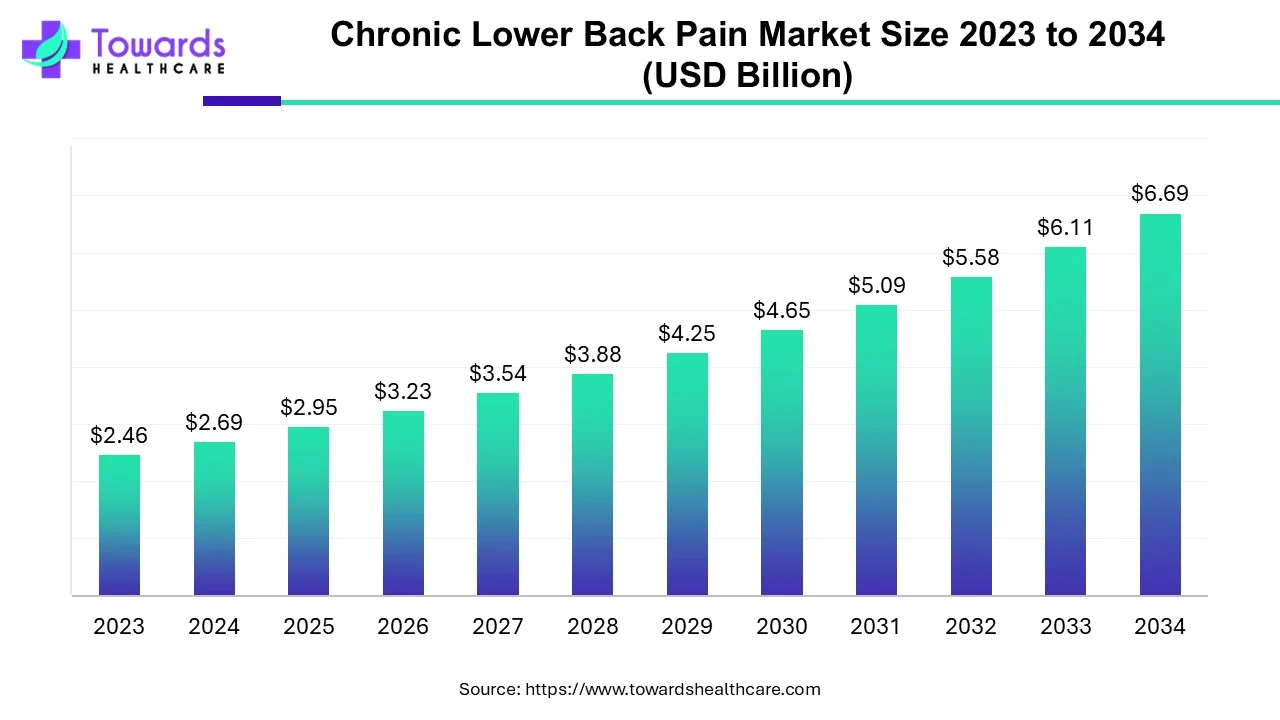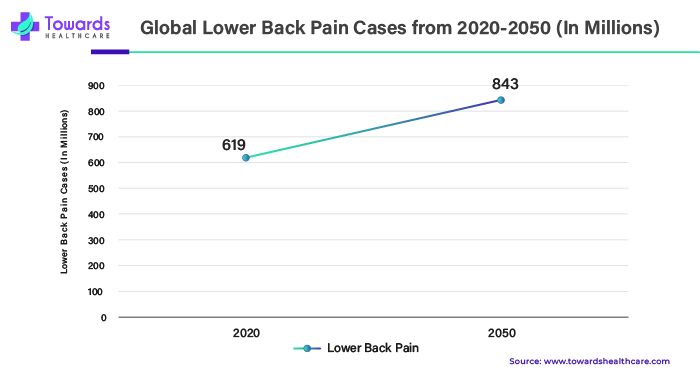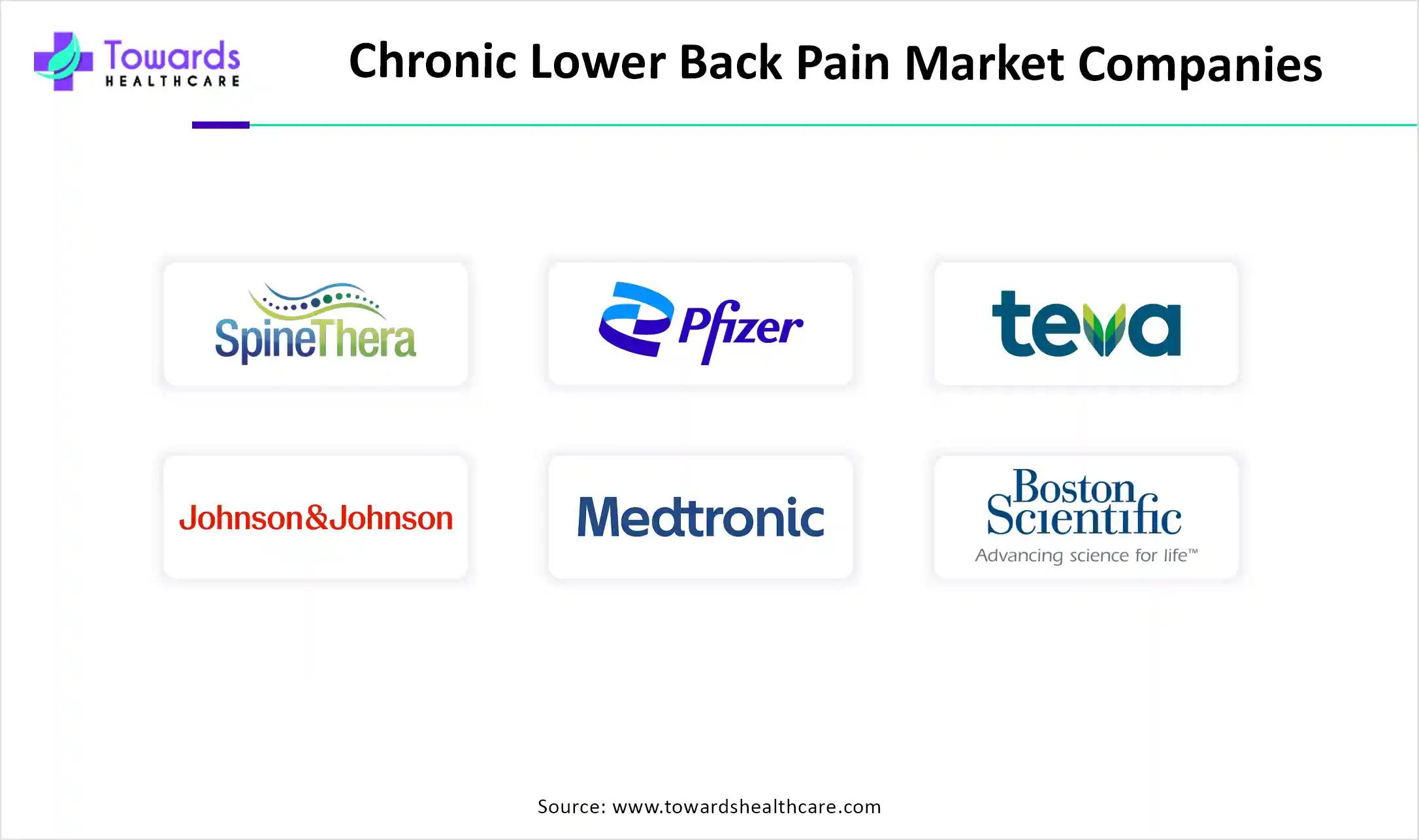November 2025

The chronic lower back pain market size is predicted to grow from USD 2.95 billion in 2025 to USD 6.69 billion by 2034, representing an impressive CAGR of 9.52% from 2024 to 2034.

The chronic lower back pain market deals with all the aspects associated with chronic lower back pain, which includes research & development, development of medication, disease monitoring, treatment, and post-treatment care. Even after an original injury or underlying cause of acute low back pain has been addressed, lower back pain that persists for more than 12 weeks or three months is referred to as chronic low back pain (CLBP). In the past ten years, the frequency of CLBP in adults has climbed by over 100%, and as the population ages, it will continue to rise sharply, impacting men and women of all ethnic backgrounds. Some of the main reasons for lower back pain are age, smoking, heredity, degree of fitness, weight increase, and occupational variables, in addition to mental health issues. Healthcare facilities, drug manufacturers, pharmacies, academic institutions, research centers, and assisted living facilities all play a role in the expansion of the chronic lower back pain market.
The ailment for which the highest number of people may benefit from rehabilitation is lower back pain (LBP), which is also the biggest cause of disability globally. Any age can suffer LBP, and most individuals will at some point in their lives. The largest age range for LBP patients is between 50 and 55 years old, while the prevalence rises with age up to 80 years old. LBP is more common in females. Several factors can contribute to back pain, which is driving the growth of the chronic lower back pain market. Those over 30 may experience pain as spinal disks wear down over time. Additionally, excess weight can put pressure on the spine, leading to discomfort.
Poor overall health, including weakened muscles and a sedentary lifestyle, can also contribute to back strain. Certain occupations involving heavy lifting or repetitive bending may increase the risk of back injuries. Structural issues like scoliosis can also cause severe back pain. Additionally, a family history of osteoarthritis, certain cancers, and other diseases may raise the risk of low back pain. Mental health can also play a role, as depression and anxiety are known to contribute to back pain. Understanding these risk factors can help individuals take preventive measures to maintain a healthy back.

The limited options for treatment available to individuals with CLBP might have a big impact on patient care. The complexity of lower back pain may be the cause of this limitation. The effectiveness of treatment may vary from person to person. Therefore, it can be difficult to create a strategy that works for everyone. The idea of limited treatment options can also be applied to the accessibility of non-invasive, non-pharmacological interventions, as certain individuals may need or favor complementary therapies like acupuncture, physical therapy, or chiropractic adjustments. Further exploration and innovative ideas in the field of CLBP management are required to tackle this important health concern. If there are no widely accepted therapies that work for everyone, patients and medical professionals may become unsatisfied.
In order to address age-related spinal disc deterioration, which can result in disorders including osteoarthritis, nerve entrapment, and spinal cord compression, advances in spine therapy have led to the development of man-made discs. Conventional therapies, such as spinal fusion surgery, have drawbacks and may cause side effects, including faster disc degeneration in the surrounding area. Simple artificial discs don't have the strength or mobility that they need. Using stem cells in an artificial polymer gel matrix combined with foam is a novel way to mimic the properties of a normal spinal disc. These artificial discs function similarly to normal discs, according to animal experiments where transplanting was successful. Treatment for degenerative spinal disorders and persistent lower back pain may be completely changed by this invention.
By drug class, the non-steroidal anti-inflammatory drugs segment dominated the chronic lower back pain market in 2023. Anti-inflammatory, pain, and fever-reducing drugs are known as NSAIDs. Both with and without a prescription, there are several varieties of NSAIDs accessible. They are used by doctors to treat a variety of conditions, such as dental pain, rheumatism, headaches, and strained muscles. Back pain is most commonly treated with NSAIDS, such as naproxen, ibuprofen, and diclofenac. They frequently provide minor relief of symptoms. The over-the-counter market offers these medications in lower dosages. Intranasally given NSAIDs can be taken as a pill form.
By drug class, the opioids segment held the second-largest share of the chronic lower back pain market and is expected to grow at the fastest rate during the forecast period. Opioids are stronger, prescription-only medicines used to treat low back pain if previous therapies are insufficiently effective. Morphine is the opioid most people are familiar with. Buprenorphine, codeine, hydromorphone, oxycodone, tapentadol, tilidine, and tramadol are some other opioids. The potencies of opioids differ. Opioids are incredibly useful in treating a wide range of acute pain conditions.
By route of administration, the oral segment dominated the chronic lower back pain market in 2023. Oral medicine administration is a typical way of drug delivery since it has so many advantages. Because it is simple and non-invasive, patients may just take their medication without needing to receive injections or go through other difficult procedures. These are its primary benefits. This might lead to improvements in patient compliance and treatment outcomes overall. Furthermore, taking oral medications on one's own is typically easy, which can ease the burden on doctors and lower healthcare costs. Due to their well-absorbed nature and regular patterns of absorption, oral drugs also make dose calculations and prescription administration simpler. Because of its flexible formulation, which also makes taste masking and extended-release formulations possible, the oral route provides a better overall patient experience.
By route of administration, the topical segment is growing significantly in the chronic lower back pain market. Applying medicine directly to the afflicted region has various benefits when it comes to pain alleviation. First of all, it delivers immediate, focused pain relief where it is most required. It is also simple to use, as it doesn't need to consume tablets or water. Furthermore, topical painkillers often have a better safety profile and milder possible adverse effects when taken as prescribed than oral painkillers. Usually, irritability at the application site is the most frequent adverse effect. If you have any doubts concerning the usage of a topical pain reliever, it's crucial to always read and abide by the product label and speak with a doctor. Topical medications can also be used to treat a variety of pain conditions, such as sprains and strains, back, muscular, neck, and shoulder pain, joint, knee, wrist, and elbow pain, arthritis, and joint pain.
For instance,
By distribution channel, the retail & online segment dominated the chronic lower back pain market in 2023. Personalized consultations are made possible through walk-in interactions with pharmacists. They can provide information about side effects, interactions, and cost-effective substitutes for medications. In order to offer patients a more comprehensive treatment plan, pharmacists frequently collaborate closely with specialists and primary care physicians.
Prescriptions may be picked up alongside daily necessities to save time and effort. Through better drug adherence, more affordable prices, enhanced patient accessibility, and more effective prescription administration, online pharmacies can reduce expenses for both patients and the healthcare system. Because they provide safe, legal prescription processing and provide thorough pharmaceutical information, their contributions to the healthcare system ultimately lead to better health outcomes and more efficient use of resources.
By region, North America dominated the chronic lower back pain market in 2023 with the largest market share. The Centers for Disease Control and Prevention estimate that 50 million individuals in the U.S. suffer from chronic pain, which is defined as persistent pain lasting more than six months. Compared to the general population, persistent pain is more common and severe in veterans. Depression, anxiety, insomnia, a worse quality of life, and drug abuse disorders can all be influenced by chronic pain. It increases the chance of suicide as well. Adults with low back pain have one of the highest rates of disability in the U.S., and their usage of opioids can have negative side effects.
A recent bout of back discomfort has been reported by over 65 million Americans. Eight percent of adults, or around 16 million people, have chronic or persistent back pain, which limits their ability to do some daily tasks. The sixth most expensive medical problem in the U.S. is back pain. The annual cost of healthcare and related indirect expenses related to back discomfort exceeds $12 billion. An estimated 83 million workdays are missed annually as a result of back discomfort.
One of the most prevalent chronic illnesses in Canada is back pain. The majority of adults four out of five will at some point in their life have back pain, with the age range of 30 to 50 being the most common cases. Men and women both have back issues on equal occasions. An estimated $6 to $12 billion is spent on medical expenses in Canada alone each year for treating low back pain. This amount does not include the costs incurred by society as a result of worker productivity losses from absences from work and the resulting disability benefits.
Asia-Pacific is fastest fastest-growing segment in the chronic lower back pain market, as a growing aging population in this region. Chronic back pain is generally age-related this caused due to the Arthritis of the spine, the slow thinning of the cartilage in the spine, and Spinal stenosis reduction of the spinal canal that may cause nerve pain. Asia and the Pacific are at the worldwide forefront of economic opportunity, and in efforts to secure a sustainable future, growing urbanization and desk-bound jobs are increasing the prevalence of poor posture, physical inactivity, and obesity in Asia Pacific. These factors all contribute to back pain.
In China, rising awareness and diagnosis rates are particularly high in the urban diagnosis centres with advanced healthcare access. China is experiencing a growing demand for medical care services, medical devices, and pharmaceuticals. China’s hospital network is the largest and most complex worldwide, comprising both private and public facilities. China's medical tourism sector is presently in its promising stages of development. The huge growth of inbound tourism is a direct result of China's commitment to high-level growth opportunities, which drives the growth of the market.

| Company Name | Medtronic |
| Headquarters | Dublin, Ireland |
| Recent Development | In April 2024, a novel spinal cord implant designed to alleviate chronic pain received approval from the US Food and Drug Administration, according to Medtronic. This move is an attempt to reach a patient group that is mostly dependent on opioid drugs. A novel spinal cord implant designed to alleviate chronic pain was authorized by the US Food and Drug Administration on Friday, marking a significant step forward for Medtronic as it attempts to reach a patient group that is mostly dependent on opioid drugs. |
| Company Name | Boston Scientific Corporation |
| Headquarters | Massachusetts, U.S. |
| Recent Development | In February 2024, the FDA authorized an additional indication for the WaveWriterTM SCS Systems to treat persistent low back and leg pain in individuals who have never had back surgery; this condition is known as non-surgical back pain (NSBP), according to a statement released today by Boston Scientific Corporation (NYSE: BSX). |
By Drug Class
By Route of Administration
By Distribution Channel
By Region
November 2025
November 2025
December 2025
November 2025